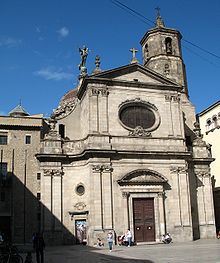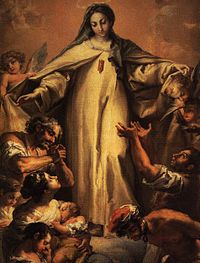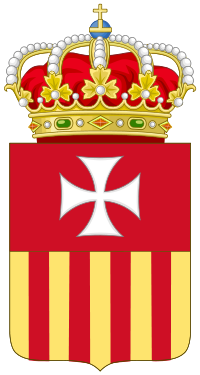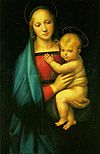- Order of the Blessed Virgin Mary of Mercy
-
 Peter Nolasco (1189-1256), founder of the Order of the Blessed Virgin Mary of Mercy.
Peter Nolasco (1189-1256), founder of the Order of the Blessed Virgin Mary of Mercy.
The Royal, Celestial and Military Order of Our Lady of Mercy and the Redemption of the Captives also known as Our Lady of Ransom is a Roman Catholic religious order established in 1218 by St. Peter Nolasco in the city of Barcelona, at that time in the Kingdom of Aragon, for the redemption of Christian captives. [1][2] One of the distinguishing marks of the Order of the Blessed Virgin Mary of Mercy is that, since its foundation, its members are required to take a Fourth Vow to die for another who is in danger of losing their Faith. The Order exists today in 17 countries.
Contents
General Background
The Order of the Blessed Virgin Mary of Mercy (or the Order of Merced, O.Merc., Mercedarians, the Order of Captives, or the Order of Our Lady of Ransom) was one of many dozens of associations that sprang up in Europe during the 12th and 13th centuries as institutions of charitable works. The work of the Mercedarians was in ransoming impoverished captive Christians (slaves) held in Muslim hands, especially along the frontier that the Crown of Aragon shared with al-Andalus (Muslim Spain).
Starting before the First Crusade, many hospices and hospitals were organized by the chapters of cathedrals or by the monastic orders. Within the communal organizations of towns, local charitable institutions such as almshouses were established by confraternities or guilds, or by successful individual laymen concerned with the welfare of their souls, but often only local historians are aware of them.
Broader-based and aristocratically-funded charitable institutions were more prominent and are more familiar, and the episodes of aristocratic and even royal ransom and its conditions, were the subject of chronicle and romance. The knights of the original Order of St John—the Knights Hospitaller—and the Templars in their origins are well known, and the impact of their organized charity upon the religious values of the High Middle Ages is more fully estimated in their spheres.
The Order of Merced, however, an early 13th century popular movement of personal piety organized at first by the Catalan Peter Nolasco, was concerned with ransoming the ordinary men who had not the means to negotiate their own ransom, the "poor of Christ." Nolasco and the fraternity that grew around him were motivated by an urban mentality that transcended kith and kin in a broader social consciousness; though they were lay folk, such a movement could only find expression through a specifically Christian form[citation needed]: within its first five or six years the movement was organized into a recognized order of the Church, still in the early 13th century the one transcendent institutional framework in Europe aside from the Papacy. (Brodman 1986).
The Foundation of the Order
 Convento de la Merced, founded in 1607, is a Merecedarian convent, which now serves as a church, in the small town of Valdunquillo, in northern Castile.
Convento de la Merced, founded in 1607, is a Merecedarian convent, which now serves as a church, in the small town of Valdunquillo, in northern Castile.
Sources for the origins of the Mercedarians are scant and almost nothing is known of the founder, St. Peter Nolasco. A narrative developed between the fifteenth and early seventeenth centuries that culminated in Nolasco's canonization as a saint in 1628. This is a summary of that narrative. St. Peter Nolasco began his redemptive work (ransoming Christian captives) in 1203.
After fifteen years of admirable mercy in the redemption of Christian captives, Peter Nolasco and his friends were seeing with concern that, instead of decreasing, day by day the number of captives was growing excessively. The determined leader, with a strong personality, clear ideas, a strong faith, a solid and balanced devotion to Christ and to his Blessed Mother, a compassionate heart, a serene and resolute trust in God, Peter Nolasco did not feel overwhelmed by the magnitude of the mission undertaken and his own insignificance[citation needed]. In his fervent prayer, he sought divine inspiration to be able to continue God’s work which he had started[citation needed]. At that point and in these circumstances, during the night of August 1, 1218, a special intervention of Blessed Mary occurred in Peter Nolasco’s life[citation needed]: an amazing Marian experience which illumined his mind and stirred up his will to transform his group of lay redeemers into a Redemptive Religious Order which, with the Church’s approbation and the protection of the Count of Barcelona and King of Aragon , would pursue the great work of mercy which had started[citation needed].
On the next day, Peter Nolasco went to the royal palace to explain his project to young Count of Barcelona and King of Aragon, James I and his advisers, the first of whom was the Bishop of Barcelona, don Berenguer de Palou. Peter’s plan, inspired by God through Mary[citation needed], was to establish a well-structured and stable Redemptive Religious Order under the patronage of Blessed Mary. The proposal pleased the king and his advisers since, after the failed attempt by Alfonso II with the Order of the Holy Redeemer which did not prosper, the noble aspiration of the royal house of Aragon to have its own redemptive order[citation needed] was becoming a reality.
 La Mercè basilica in Barcelona at the place where the Mercedarian motherchurch was built in 1267
La Mercè basilica in Barcelona at the place where the Mercedarian motherchurch was built in 1267
On August 10, 1218, the new religious order for the Redemption of Captives was officially and solemnly constituted at the main altar erected over Saint Eulalia's tomb in the Cathedral of the Holy Cross (also known as the Cathedral of Santa Eulalia) in Barcelona. Bishop Berenguer de Palou gave Peter Nolasco and his companions the white habit that they would wear as characteristic of the Order; he gave them the Rule of Saint Augustine as a norm for their life in common and he gave his authorization for the sign of his cathedral, the Holy Cross, to be on the habit of the Order. After that, Peter Nolasco and the first Mercedarians made their religious profession right there before the bishop.
For his part, King James I the Conqueror established the Order as an institution recognized by the civil law of his kingdom. In the very act of the foundation and as an important rite of the ceremony, the monarch gave the Mercedarian friars the habit[citation needed] which, in the language of military orders, is the shield with four red stripes over a gold background, that is to say, the sign of the king himself[citation needed]. Along with the cross of the cathedral, this emblem would form the Order’s own shield. On that memorable day, James I endowed the Order, of which he considered himself the founder[citation needed], with the Hospital of Saint Eulalia which served as the first Mercedarian convent and as a house of welcome for redeemed captives.
Reconstructing the Order's beginnings from the documentary record produces a far less detailed story. In this the year 1218 plays no role. The founder first appears ca. 1226 as a collector of alms in Perpignan. By 1230 he is collecting alms for captives in Barcelona as the head of a small laic confraternity. During the next six years, this confraternity slowly evolves into a religious order as members obtain properties in Catalonia and in the newly conquered, frontier regions of Mallorca and Valencia. In 1236, Pope Gregory IX granted the Mercedarians formal recognition as a religious order under the Rule of St. Augustine. The small order gained additional members, property and support in the 1250s and 1260s. While evidenve is scant, one has to assume that this support came in recognition of the Order's work in ransoming captives in a war zone that remained quite active. The growing pains, however, also caused institutional turmoil, whose outlines can only be glimpsed. The visible result was a reorganization in 1272 by a new master, Pere d'Amer. James I, whose descendants claimed him to be the Mercedarian founder, had in fact no documentable contact with the Order until the late 1230s and early 1240s, at which time he granted formerly Muslim lands in Valencia, especially the Shrine of Santa Maria del Puig. It was not until the 1250s that royal patronage becomes evident, when the king granted the Order his guidaticum (a form of diplomatic protection), economic privileges that promoted gifts to the Order, and, at least temporarily, the important shrine of St. Vincent in the City of Valencia. Claims by King James II and Peter IV of a royal foundation of the Order reflected not real history but their own designs upon the Order's financial resources and personnel.
In the proem of the first Constitutions of the Mercedarian Order of 1272, three very important elements referring to the foundation stand out: the name, the founder and the purpose of the Order.
The name with which the Order founded by Peter Nolasco is identified, is mentioned first. Prior to the 1272 Constitutions, the Order had several names among which: Order of Saint Eulalia, Order of the Mercy of Captives, Order of the Redemption of Captives, Order of Mercy. But the proper and definitive title is: Order of the Virgin Mary of Mercy of the Redemption of Captives.
Then it is stated that Brother Peter Nolasco has been constituted "servant, messenger, founder and promoter" of the new Institute. Peter Nolasco is the real founder of the Order or the "Procurator of the alms of captives" as defined on March 28, 1219, by the first document referring to him after the foundation.
Finally, it is clearly specified that the purpose of the Order is "to visit and to free Christians who are in captivity and in power of the Saracens or of other enemies of our Law… By this work of mercy… all the brothers of this Order, as sons of true obedience, must always be gladly disposed to give up their lives, if it is necessary, as Jesus Christ gave up his for us."
All these valuable and reliable historical details of the foundation of the Order of Mercy are gathered in the letter of January 11, 1358, sent by Peter IV of Aragon the Ceremonious to Pope Innocent VI and kept to this day in the Archives of the Aragon Crown, a reliable guarantee of all the Mercedarian history of the first centuries[citation needed].
With the solemn and official support of the Church and of the state, Peter Nolasco and his friars, constituted as a Redemptive Religious Order of lay brothers, gained new energy and, with renewed fervor, they continued their peregrinations of charity to collect alms for the redemption of captives in Saracen lands[citation needed].
General articles
Overview of Mariology •
Veneration of the Blessed Virgin • History of MariologyExpressions of devotion
Art • Hymns • Music • ArchitectureSpecific articles
Apparitions • Saints • Popes • Societies • Hearts of Jesus & Mary • Consecration to MaryThe Fourth Vow
Some Orders and Congregations, besides the three vows of religion, add particular vows.
These additional vows are part of the nature of the profession of each Order and are permitted by the Church. They can be solemn or simple, perpetual or temporary. The Fourth Vow of the Order of Mercy is a Solemn Vow. In accordance with the general principle of a vow, it is an act of the will and an authentic promise in which the reason for the vow is perfection. It also presupposes a sincere will of obligation in conscience and by virtue of the community.
The Fourth Vow in the Various Constitutions of the Order
- In the First Constitutions of the Order, the Amerian Constitutions (1272): "... all the brothers of the Order must always be gladly disposed to give up their lives, if it is necessary, as Jesus Christ gave up his for us..."
- The Albertine Constitutions (1327): "Chapter 28: Surrender of one’s life as hostage in Saracen Territory."
- The Zumelian Constitutions (1588): "I will be obedient to you and your successors up to death; and I will remain in person in the power of the Saracens if it be necessary for the Redemption of Christ’s Faithful."
- The Madrilene Constitutions (1692) and the Roman Constitutions (1895): "Therefore, we must understand in the first place, that all our religious are committed to the Redemption of Captives in such a way that they must not only always be disposed to carry it out in fact if the Order sends them, but also to collect alms, or if the prelates do select them, to do whatever else may be necessary for the act of redemption to be carried out."
- Also in the Madrilene Constitutions: "We declare that this vow is essential because it inseparably constitutes our Order in its nature and substance by virtue of the early institution… and our predecessors have always professed and fulfilled it."
- The Constitutions and Norms (1970): "The Mercedarian, urged by Charity, dedicated himself to God by a particular vow in virtue of which he promises to give his own life, if it will be necessary, as Christ did for us, to free from the new forms of slavery the Christians who are in danger of losing their Faith."
- The Aquarian Constitutions (1986): "In order to fulfill this mission we, impelled by love, consecrate ourselves to God with a special vow, by virtue of which we promise to give up our lives, as Christ gave his life for us, should it be necessary, in order to save those Christians who find themselves in extreme danger of losing their faith by new forms of captivity."
See also
- Scapular of Our Lady of Ransom
- Our Lady of Mercy
References
- ^ Ann Ball, 2003 Encyclopedia of Catholic Devotions and Practices ISBN 087973910X page 525
- ^ Mary's Praise on Every Tongue: A Record of Homage Paid to Our Blessed Lady by Chandlery Peter Joseph 2009 ISBN 111316154X page 181
External links
Categories:- Medieval Catalan and Occitan history
- Mendicant orders
- 1218 establishments
- Christian religious orders established in the 13th century
- Military orders
- Blessed Virgin Mary of Mercy Order
Wikimedia Foundation. 2010.



